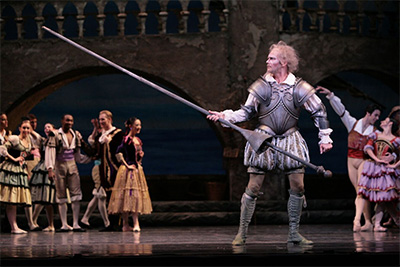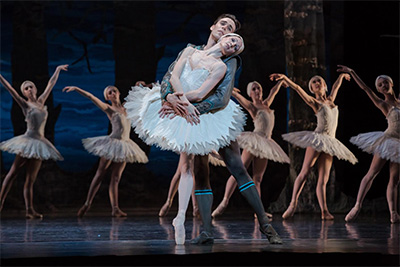Melody Mennite and Artists of Houston Ballet in Stanton Welch’s The Four Seasons.
Photo by Amitava Sarkar, courtesy of Houston Ballet.

At first glance, Houston Ballet’s 2017/2018 Season can look like a crash course in ballet, with something for everyone, including ballet connoisseurs, contemporary enthusiasts and those completely new to the art form.
Starting off the season with the mixed repertory, Poetry in Motion, Sept. 8-17, is a perfect example. In one program, audiences get a taste of three masters of ballet: George Balanchine, Christopher Wheeldon OBE, and Houston Ballet’s own artistic director, Stanton Welch AM.
The last time Houston Ballet performed Balanchine’s epic masterpiece, Symphony in C, a hurricane named IKE showed up, canceling the second week of performances. “It’s been too long since we performed Symphony in C, and because it was cut short, there are many dancers who have not performed it, so we just have to bring it back,” explains Welch.
Wheeldon’s romantic tribute to Rogers and Hammerstein’s treasured Broadway musical, Carousel (A Dance), was created in 2002 as a pièce d’ occasion for the New York City Ballet. “This is a great time to have Chris’s work since he recently won the Tony Award for An American In Paris,” says Welch.
We get a taste of Welch’s early years as a choreographer with Powder, which premiered on the Royal Birmingham Ballet while he was still dancing 17 years ago. Set to Mozart’s gorgeous Clarinet Concerto in A Major, Powder follows seven couples as they costume themselves, hence, “Powder.” “It’s sexy and funny,” says Welch. “I find that in Mozart.”

Next up, Sept. 21- Oct. 1, is the Houston premiere of Mayerling, Sir Kenneth MacMillan’s three-act narrative ballet chronicling the murder-suicide of Crown Prince Rudolf, the sole heir to the Austro-Hungarian Empire, and his mistress Baroness Mary Vetsera. It’s a natural choice for a company so adept at dramatic storytelling. Welch urges us to think Masterpiece Theater. “It’s like MacMillan’s Manon, but bigger and darker,” Welch explains. “The company has been itching to do it, and it has such sensational roles. There’s beautiful pas de deux, too. It’s political, personal and all true.”
During the holiday months, Nov. 24-Dec. 28, we get another chance to see Welch’s lavish new production of The Nutcracker, “It’s meant for multiple views; it’s like going to Disneyland,” jokes Welch. “We had seven different casts last year and they were all so different. The ballet is really guided by whoever is dancing the role of Clara.” The annual ballet smorgasbord Jubilee of Dance on Dec.1 is yet another holiday highlight.
The new year starts off with another epic ballet, Welch’s Swan Lake, Feb. 22-March 4. Houston Ballet brings Swan Lake back every four years for several reasons: audiences love it, and the dancers need a chance to re-visit or debut in these iconic roles. “This was the first full-length ballet I did for Houston Ballet, so it’s important in that way,” says Welch. “It’s really grown into its own. I will be re-working it somewhat, and it will be stronger because the company has developed so much since it premiered in 2006.”
Busting out of classical mode comes Rock, Roll & Tutus, March 8-18, featuring a world premiere by Welch, Songs of Last Century, the Houston premiere of Tim Harbour’s Filigree and Shadow and Alexander Ekman’s cheeky homage to ballet, Tulle. Ekman’s Cacti was such a hit last season, dancers and audiences were clamoring for more of his whimsical and provocative work. Expect the unexpected in Ekman’s romp, which contains talking, projections, film and improvisation. “Tulle is definitely outside of the ballet bubble,” says Welch. “This is a spectacular full company piece, that’s both comic and clever. He’s such a rhythmic and musical choreographer.”

The title reveals the idea behind Welch’s world premiere Songs of Last Century, as he traipses through time using popular dance tunes from 1900-2000. “I’ve had this idea for a long time, I’ve always loved mixed tapes, and this is kind of like that.” The ballet will also deal with social dancing and how that changed through the Century.
Welch is excited to introduce Houston Ballet audiences to Harbour, his peer from The Australian Ballet. “His influences, such as Kylián and Forsythe, are very similar to mine, yet he has a unique voice. It’s really physical work, yet incorporates some pedestrian movement, too,” adds Welch.
Global Movements, May 23-June 3, features works by Welch, Trey McIntyre, a former Choreographic Associate at Houston Ballet, and William Forsythe. Welch finds Forsythe’s Pas/Parts 2016 a complete turnaround from the last work the company performed by this contemporary giant. “It’s a counterpoint to Artifact Suite,” says Welch. “We get to see Billy in a very different style. It’s like free form jazz, especially in the pas de deux. The ballet also has a zappy ending. He’s good at that.”
Welch first saw McIntyre’s In Dreams (2007) when Houston Ballet was sharing the stage with the Memphis Ballet at Ballet Across America at the Kennedy Center in 2010. He was quite taken with McIntyre’s treatment of Roy Orbison’s haunting anthems. “Trey’s In Dreams is such a complete ballet, no gimmicks, just lovely dancing with a wonderful emotive appeal. It really demonstrates Trey’s level of maturity as a choreographer.” Welch’s elegiac ballet, The Four Seasons, which follows the passage of time from a woman’s perspective, is one of the few ballets that has a role for a mature dancer. “This was a popular piece to popular music,” explains Welch. “It’s been so long since we have performed this ballet that some of these dancers have moved on to a new season.”
It’s been more than a decade since Houston Ballet dancers have inhabited the coveted roles of Kitri and Basilio in Ben Stevenson’s Don Quixote, which closes the season, June 7-17. “Don Q is Ben’s blockbuster. It’s the ballet that made Carlos Acosta and Lauren Anderson stars, and it’s long overdue,” says Welch. “Our dancers need a chance to dance these roles.” With Stevenson’s dazzling choreography, Houston Ballet’s technical fireworks and Ludwig Minkus’s rousing score, Don Q may indeed be one fiery end to a terrific season.
—NANCY WOZNY
Reprinted from Playbill.

